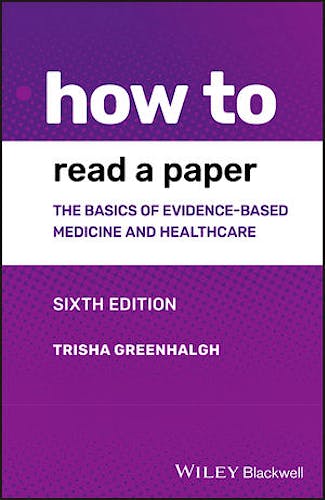

No hay productos en el carrito



How to Read a Paper. The Basics of Evidence-Based Medicine and Healthcare
Greenhalgh, T.
6ª Edición Abril 2019
Inglés
Tapa blanda
288 pags
412 gr
14 x 22 x 2 cm
ISBN 9781119484745
Editorial WILEY
LIBRO IMPRESO
-5%
44,87 €42,63 €IVA incluido
43,14 €40,99 €IVA no incluido
Recíbelo en un plazo de
2 - 3 semanas
LIBRO ELECTRÓNICO
-5%
37,80 €35,91 €IVA incluido
36,35 €34,53 €IVA no incluido
Acceso On Line
Inmediato
Foreword to the first edition by Professor Sir David Weatherall
Preface to the sixth edition
Preface to the first edition
Acknowledgements
Chapter 1 Why read papers at all?
- Does ‘evidence-based medicine’ simply mean ‘reading papers in medical journals’?
- Why do people sometimes groan when you mention evidence-based healthcare?
- Before you start: formulate the problem
- Exercises based on this chapter
- References
Chapter 2 Searching the literature
- What are you looking for?
- Levels upon levels of evidence
- Synthesised sources: systems, summaries and syntheses
- Pre-appraised sources: synopses of systematic reviews and primary studies
- Specialised resources
- Primary studies – tackling the jungle
- One-stop shopping: federated search engines
- Asking for help and asking around
- Online tutorials for effective searching
- Exercises based on this chapter
- References
Chapter 3 Getting your bearings: what is this paper about?
- The science of ‘trashing’ papers
- Three preliminary questions to get your bearings
- Randomised controlled trials
- Cohort studies
- Case–control studies
- Cross-sectional surveys
- Case reports
- The traditional hierarchy of evidence
- Exercises based on this chapter
- References
Chapter 4 Assessing methodological quality
- Was the study original?
- Whom is the study about?
- Was the design of the study sensible?
- Was bias avoided or minimised?
- Was assessment ‘blind’?
- Were preliminary statistical questions addressed?
- A note on ethical considerations
- Summing up
- Exercises based on this chapter
- References
Chapter 5 Statistics for the non-statistician
- How can non-statisticians evaluate statistical tests?
- Have the authors set the scene correctly?
- Paired data, tails and outliers
- Correlation, regression and causation
- Probability and confidence
- The bottom line
- Summary
- Exercises based on this chapter
- References
Chapter 6 Papers that report trials of drug treatments and other simple interventions
- ‘Evidence’ and marketing
- Making decisions about therapy
- Surrogate endpoints
- What information to expect in a paper describing a randomised controlled trial: the CONSORT statement
- Getting worthwhile evidence from pharmaceutical representatives
- Exercises based on this chapter
- References
Chapter 7 Papers that report trials of complex interventions
- Complex interventions
- Ten questions to ask about a paper describing a complex intervention
- Exercises based on this chapter
- References
Chapter 8 Papers that report diagnostic or screening tests
- Ten men in the dock
- Validating diagnostic tests against a gold standard
- Ten questions to ask about a paper that claims to validate a diagnostic or screening test
- Likelihood ratios
- Clinical prediction rules
- Exercises based on this chapter
- References
Chapter 9 Papers that summarise other papers (systematic reviews and meta-analyses)
- When is a review systematic?
- Evaluating systematic reviews
- Meta-analysis for the non-statistician
- Explaining heterogeneity
- New approaches to systematic review
- Exercises based on this chapter
- References
Chapter 10 Papers that tell you what to do (guidelines)
- The great guidelines debate
- Ten questions to ask about a clinical guideline
- Exercises based on this chapter
- References
Chapter 11 Papers that tell you what things cost (economic analyses)
- What is an economic analysis?
- Measuring the costs and benefits of health interventions
- A note of choosing wisely
- Ten questions to ask about an economic analysis
- Conclusions
- Exercises based on this chapter
- References
Chapter 12 Papers that go beyond numbers (qualitative research)
- What is qualitative research?
- Ten questions to ask about a qualitative research paper
- Exercises based on this chapter
- References
Chapter 13 Papers that report questionnaire research
- The rise and rise of questionnaire research
- Ten questions to ask about a paper describing a questionnaire study
- Conclusions
- Exercises based on this chapter
- References
Chapter 14 Papers that report quality improvement case studies
- What are quality improvement studies, and how should we research them?
- Ten questions to ask about a paper describing a quality improvement initiative
- Exercises based on this chapter
- References
Chapter 15 Papers that describe genetic association studies
- The three eras of human genetic studies (so far)
- What is a genome-wide association study (GWAS)?
- Clinical applications of GWAS
- Direct-to-consumer genetic testing
- Mendelian randomisation studies
- Epigenetics – a space to watch
- Ten questions to ask about a genetic association study
- Conclusions
- Exercises based on this chapter
- References
Chapter 16 Applying evidence with patients
- The patient perspective
- Patient-reported outcome measures (PROMs)
- Shared decision-making
- Option grids
- N of 1 trials and other individualised approaches
- Exercises based on this chapter
- References
Chapter 17 Criticisms of evidence-based healthcare
- What’s wrong with EBHC when it’s done badly?
- What’s wrong with EBHC when it’s done well?
- Why is ‘evidence-based policymaking’ so hard to achieve?
- Exercises based on this chapter
- References
Appendix 1 Checklists for finding, appraising and implementing evidence
Appendix 2 Assessing the effects of an intervention
Index
Required reading in many medical and healthcare institutions, How to Read a Paper is a clear and wide-ranging introduction to evidence-based medicine and healthcare, helping readers to understand its central principles, critically evaluate published data, and implement the results in practical settings. Author Trisha Greenhalgh guides readers through each fundamental step of inquiry, from searching the literature to assessing methodological quality and appraising statistics.
© 2025 Axón Librería S.L.
2.149.0